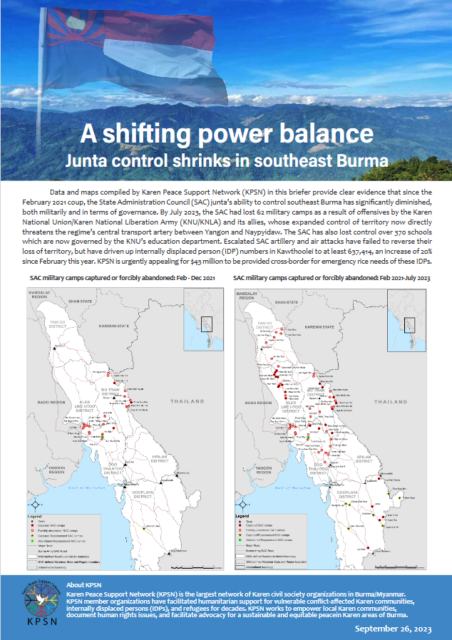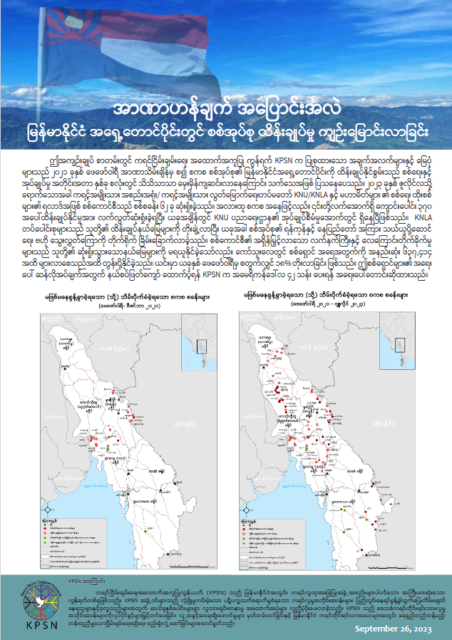A shifting power balance: Junta control shrinks in southeast Burma



Data and maps compiled by Karen Peace Support Network (KPSN) in this briefer provide clear evidence that since the February 2021 coup, the State Administration Council (SAC) junta’s ability to control southeast Burma has significantly diminished, both militarily and in terms of governance. By July 2023, the SAC had lost 62 military camps as a result of offensives by the Karen National Union/Karen National Liberation Army (KNU/KNLA) and its allies, whose expanded control of territory now directly threatens the regime’s central transport artery between Yangon and Naypyidaw. The SAC has also lost control over 370 schools which are now governed by the KNU’s education department. Escalated SAC artillery and air attacks have failed to reverse their loss of territory, but have driven up internally displaced person (IDP) numbers in Kawthoolei to at least 637,414, an increase of 20% since February this year. KPSN is urgently appealing for $43 million to be provided cross-border for emergency rice needs of these IDPs.
Accelerating loss of SAC military camps in Kawthoolei
Comparison of the preceding maps showing locations of SAC military camps captured or forcibly abandoned by December 2021 and by July 2023, reveals an accelerating rate of loss: by the end of 2021, eleven months after the coup, 21 SAC camps had been lost, while by mid-2023, eighteen months later, a further 41 camps had been lost. The maps also highlight the widening territory in which losses have taken place. In 2021, losses were limited to Mutraw and Doo Tha Htoo districts, while by mid-2023, losses had spread northwards across Taw Oo and Kler Lwe Htoo districts, and southwards to Dooplaya district.
The topographic map shows how the SAC bases lost to KNU military action relate to major transport infrastructure and terrain. The most striking strategic gain by the KNU is its increased control over the western and eastern boundaries of its northern territories – including the Salween River borderline with Thailand — as well as over the main transport routes from central Burma into these territories. This severely hampers the regime’s ability to supply its military camps in this region, and to launch offensives against the resistance forces operating in this mountainous terrain. The KNU’s expansion westwards and southwards also poses a significant threat to the regime’s main road and rail transport artery from Yangon to Naypyidaw, as well as to the Asia Highway trade corridor from Yangon to Myawaddy on the Thai border.
These SAC territorial losses have significantly affected the regime’s ability to project governance authority in southeast Burma. The numbers of civil servants still loyal to the junta have become fewer and increasingly isolated in the pockets of SAC control within the expanded Kawthoolei territories, where the KNU is increasingly able to consolidate its own governance structures, including in the social service sectors. This is further detailed in the education governance section below.

